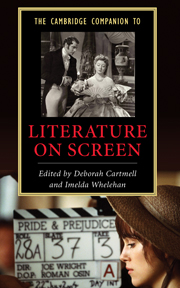Book contents
- Frontmatter
- Introduction - Literature on screen: a synoptic view
- Part One Theories of Literature on Screen
- Part Two History and Contexts
- 3 Gospel narratives on silent film
- 4 William Shakespeare, filmmaker
- 5 The nineteenth-century novel on film: Jane Austen
- 6 Modernism and adaptation
- 7 Postmodern adaptation: pastiche, intertextuality and re-functioning
- Part Three Genre, Industry, Taste
- Part Four Beyond the "Literary"
- Further reading
- Index
- Series List
5 - The nineteenth-century novel on film: Jane Austen
from Part Two - History and Contexts
Published online by Cambridge University Press: 28 September 2007
- Frontmatter
- Introduction - Literature on screen: a synoptic view
- Part One Theories of Literature on Screen
- Part Two History and Contexts
- 3 Gospel narratives on silent film
- 4 William Shakespeare, filmmaker
- 5 The nineteenth-century novel on film: Jane Austen
- 6 Modernism and adaptation
- 7 Postmodern adaptation: pastiche, intertextuality and re-functioning
- Part Three Genre, Industry, Taste
- Part Four Beyond the "Literary"
- Further reading
- Index
- Series List
Summary
The nineteenth-century novel has been a staple of twentieth-century entertainment. For decades, film companies have been producing adaptations of novels by Charles Dickens, Emily and Charlotte Brontë, Jane Austen, Wilkie Collins, George Eliot, William Makepeace Thackeray, Anthony Trollope, and Henry James, as have television companies like the BBC and ITV. Why are these authors so popular? First of all, they tell good stories. They also have name recognition and prestigious cultural associations. They provide good visuals. Finally, their works are out of copyright.
Judging by the rate of production and consumption, both American and British audiences have an insatiable hunger for films with historical settings and films based on great books. For some, historical films and serials provide entertainment, allowing a temporary escape from a modern world of care, predictability, or dullness. For others, they provide fare more intellectual than the blockbuster films that dominate at the multiplex cinema. In particular, they appeal to women (an audience that film companies have often neglected) with their foregrounding of relationships and women's issues. With the development of home VCR and DVD players, films and television serials have gained an extended life. No longer does a television adaptation vanish from the cultural consciousness after its broadcast. The success of newer adaptations even means a release on DVD of older versions, too. Thanks to the phenomenal reception of the 1995 Pride and Prejudice and Sense and Sensibility, the BBC and ITV Austen adaptations from the 1970s and early 1980s have been released in inexpensive DVD versions.
- Type
- Chapter
- Information
- The Cambridge Companion to Literature on Screen , pp. 75 - 89Publisher: Cambridge University PressPrint publication year: 2007
- 9
- Cited by

